What we know about Russia’s new ‘Fleabag’ stealth fighter: Sukhoi Checkmate Q&A with RUSI Thinktank’s Justin Bronk & update from Jim ‘Sonic’ Smith
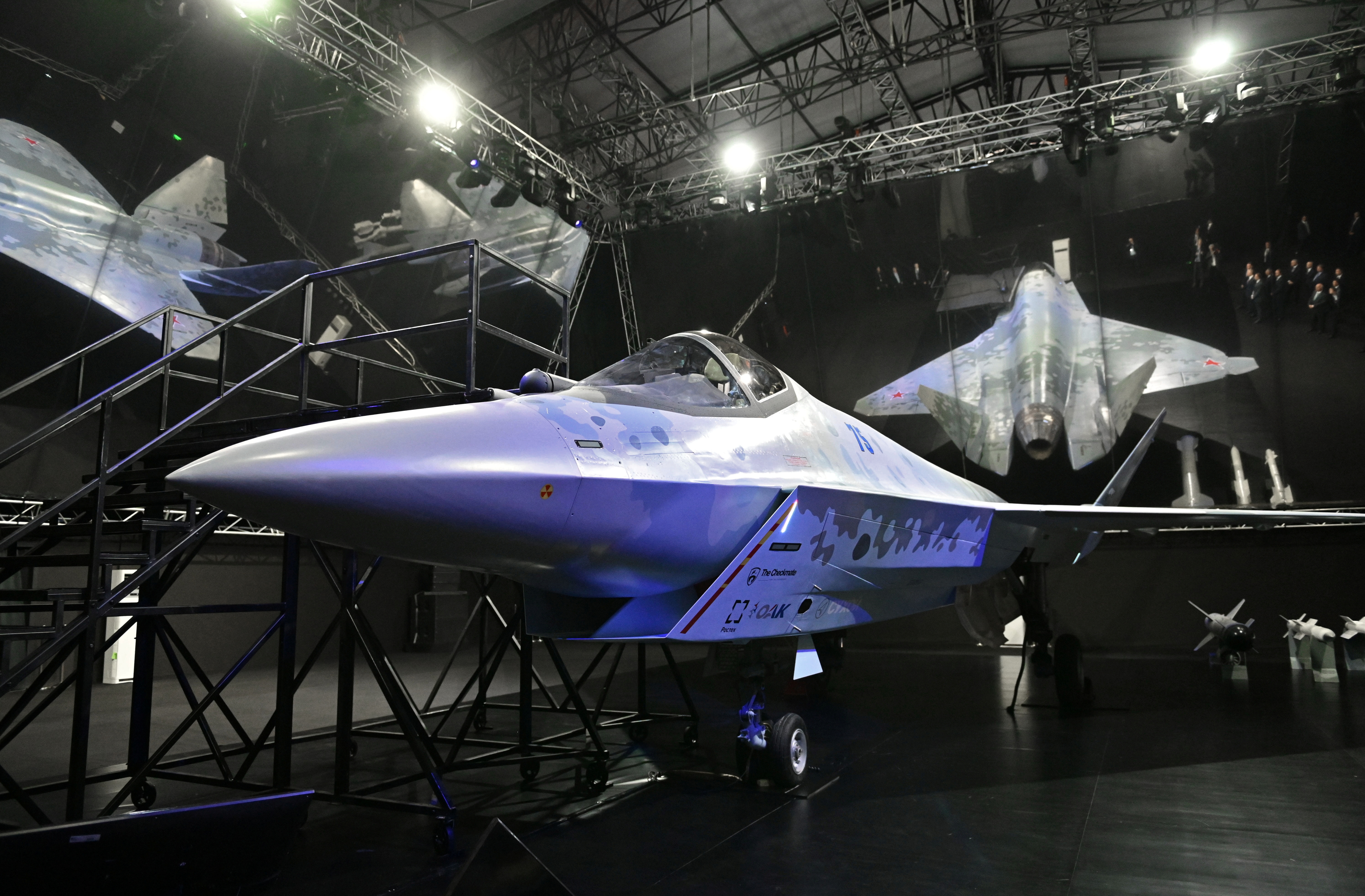
Russia reveals what is described as a prototype of a new fighter aircraft at the MAKS 21 airshow. We caught up with Justin Bronk (Research Fellow at the RUSI think-tank and Editor of RUSI Defence Systems) to find out more
Is the Checkmate at MAKS a mock-up or aircraft?
Without higher resolution images it is difficult to be certain. However, the lack of wiring and hydraulic lines within the visible parts of the main landing gear well, as well as the rather oversimplified external textures seen in the leaked footage pre-official the unveiling appear to suggest a mock up rather than a functioning aircraft.
What does the configuration reveal about the aircraft’s role and capabilities?
The Light Tactical Aircraft (LTA) designation and the configuration show that this is clearly a concept aimed at producing a relatively cheap and cheerful, somewhat low observable light fighter, primarily for the export market.
The relatively compact size and engine/intake placement will limit the space available for internal weapon bays. I would guess two IR dogfight missiles in the small side-mounted bays ahead of the main landing gear, and space for 2-4 R-77 class BVR missiles in a ventral bay. However, larger air-to-air and air-to-ground ordinance would likely have to be carried externally. It is also likely to have a modest range with internal fuel due to the competing demands for landing gear housing, weapons bays and avionics within a compact airframe.
As with the Su-57, the LTA features an Infra-Red Scan and Track (IRST) sensor embedded at the junction between the forward canopy and the nose, and will likely feature an active electronically scanned array (AESA) type radar in the nose. The latter, however, will be limited in size due to the narrow and aggressively tapered nose profile.
One particularly notable feature is the lack of conventional elevators. Instead, the LTA has canted stabilisers which are more vertical than I would have expected if a ruddervator (or V-Tail) configuration was intended to provide primary pitch authority. Instead, it would appear that pitch authority will be provided by a combination of tailless delta style elevon control and at least 2D thrust-vectoring. This suggests to me that the LTA has a lessened design emphasis on supermanoeuvrability than previous Russian fighter designs.

How far is Russia from an operational Checkmate?
I would suggest that this is a long way from an operational aircraft. The slick PR campaign and dramatic reveal at MAKS is obviously an attempt to convince some of the nations mentioned in the Rostek commercial to buy into a nascent development programme. The slow development pace and limited procurement scale of the Su-57 Felon (which is far more important to Russia’s own defence needs) shows the limits of UAC’s ability to develop the LTA to an operational aircraft without significant external funding.
Will it be used domestically? How will it aid the Su-57 force and what would it replace?
The Russian Aerospace Forces (VKS) tend to purchase a range of different combat aircraft at a small scale to keep the various formerly Sukhoi and Mikoyan design bureaus and production lines viable. Therefore, if the LTA is developed successfully into an operational aircraft, then I’m sure that the VKS will purchase it on a limited scale. However, I suspect that they would prefer to increase the quantities and maturity of the Su-57 over committing to the LTA on a large scale.
What would be the hardest technology for the Russia’s to master if the aircraft is seen as a counter/alternative to F-35?
There are three key technologies which Russia will need to master before the LTA could be seen as a competitive stealth fighter in a practical combat environment:
Firstly, they would need to master compact AESA radars for use on fighter aircraft – something which is being worked on with the Su-57 but is still causing headaches. The key issue is that to be a viable stealth fighter, an aircraft must not only be difficult to detect on radar, but must also be able to detect and engage enemy aircraft without revealing itself through the energy emitted by its radar. This capability is referred to as low-probability of intercept/low-probability of detection (LPI/LPD), and it is a vital factor in the survivability and lethality of the F-22 and F-35 which is often missed by non-specialist commentators.
In very broad-brush terms, LPI/LPD radars work by exploiting the fact that AESA radars employ hundreds of individual beams rather than one or several large and more powerful ones in a mechanically scanned or PESA type radar. Use of specific frequency, wavelength and pulse repetition techniques for these many individual beams can enable AESA radars to avoid producing an easily identifiable signature within the electronic ‘noise’ of the modern air environment. However, the programming, threat EW intelligence granularity and signal processing capabilities required are highly complex and difficult to master. Furthermore, the goalposts are constantly moving as passive electronic warfare (think detection, classification and tracking of hostile signals) capabilities improve with technology. In other words, what was LPI/LPD against Russian or Chinese systems in the 2000s is almost certainly not LPI/LPD against (say) a USAF F-35A in 2025. Without a genuinely LPI/LPD AESA radar, an operational LTA would expose its position against modern opponents every time it used its primary sensor – rendering its low-observable shaping features far less useful.
The second key technology is achieving the necessary level of industrial quality control to produce viable low-observable aircraft in quantity. While bespoke hand finishing can potentially produce relatively low-observable results for prototypes, traditionally Russian fighter manufacturing has not been conducted to the extremely fine tolerances and quality control levels required to mass produce stealth fighters. This also carries over to the maintenance side of things – can the VKS (or potential export customers for that matter) afford to change their maintenance and operating procedures to a sufficient degree to maintain stealth properties in service for any length of time? For air forces used to operating previous generations of Mikoyan or Sukhoi products (with their famously high tolerance for rough conditions), it would be a culture and budgetary shock to say the least.
The third key technology set is in the field of advanced materials science and thermal management. One of the biggest challenges in moving from a prototype that looks a bit like a 5th generation aircraft to a genuine operational capability is incorporating all the myriad sensors, avionics, life support and fuel/engine systems. All of these components, especially the sensors and fuel/engine systems generate a great deal of heat when in use. This must be managed without adding the usual ducts, ram air intakes etc which would destroy the stealth properties of the airframe. They must also all compete with fuel and weapons for very limited space within an outer mould line which is fixed for RCS control reasons. Sensors must also be covered with fairings or airframe skin which allows their own emissions to pass unimpeded, but interacts with hostile radar in such a way as to not compromise the RCS.
How will it likely differ in concept to the F-35?
The LTA is clearly aiming for a significantly lower degree of stealth at a much lower price point compared to the F-35. It can be thought of perhaps as a somewhat low-observable spiritual successor to the MiG-21, where the F-35 is intended to be a very-low observable spiritual successor to the F-16, EA-18G and F-15E.
Does a STOVL or carrier variant seem likely?
STOVL doesn’t look compatible with the airframe, as it requires such specific design features to achieve – not least positioning the centre of vertical thrust roughly on the overall centre of gravity. I also doubt that it has the required high-alpha flight characteristics and pitch authority for CATOBAR carrier operations given the intake design and previously mentioned reliance on elevons/thrust vectoring.
Do you like how it looks?
It’s certainly refreshing! A different take to add to the increasing number of mini-F-22 or F-35 clone mock ups popping up around the world. A qualified ‘yes’ on the looks front.
How much experience does Russia have in stealth and how much does it embrace the concept?
Russia lacks any experience with true VLO stealth. However, it has made significant progress with LO airframe design features in the Su-57, and it certainly has the potential to manufacture a new generation of combat aircraft (with the Felon as the centrepiece) that get past the traditional massive signature weakness of the Flanker and Fulcrum series.
I think Russia has its own take on stealth as a concept, with a firmly realistic internal appraisal of its own industrial and financial limitations, as well as the constantly improving nature of NATO sensors which make true VLO performance in a major war ever harder as a goal for future systems. For them, I think RCS reduction features are seen as key to maintaining current levels of competitiveness in the air – whilst ever improving long range SAM systems and ground based radars form the first line of defence (or offense) against NATO airpower. For me, Russian boasts about F-22 or F-35 levels of stealth in novel air systems are simply propaganda aimed at the Russian domestic audience and prospective export customers.
What should I have asked you?
How much of the technology developed at such expense and effort for the Su-57 can be leveraged for the LTA/Checkmate?
Likely export customers or partners?
The three most obvious potential candidates would be India, the UAE and Turkey. However, India is likely to be very wary after its experiences with the PAK FA/FGFA programme and poor support for the Su-30MKI fleet post acquisition. The UAE appears to be (bafflingly from my perspective) being allowed to purchase the F-35, so is unlikely to be interested in the LTA. Turkey has its own TF-X ambitions for domestic LO fighter development and has also seen ‘behind the curtain’ on F-35 before being ejected from the programme so will have very high operational expectations for any future ‘stealth’ fighter acquisition which the LTA is unlikely to be able to meet.
Otherwise, Vietnam, Argentina and Algeria are all potential candidates, but the likely competition is from more mature and lower risk offerings from China.
Where does this leave rival fighter design bureau MiG?

The MiG-35 is already a damp squib, very much in the shadow of the Sukhoi product line in Russian service and on the export market. After MiG’s recent absorption within UAC I think the composite firm will focus on its more successful Sukhoi products rather than new MiG-derived concepts. The MiG-35 It isn’t much cheaper than a Su-35S, does everything worse, no large orders, AESA radar wasn’t delivered as promised…
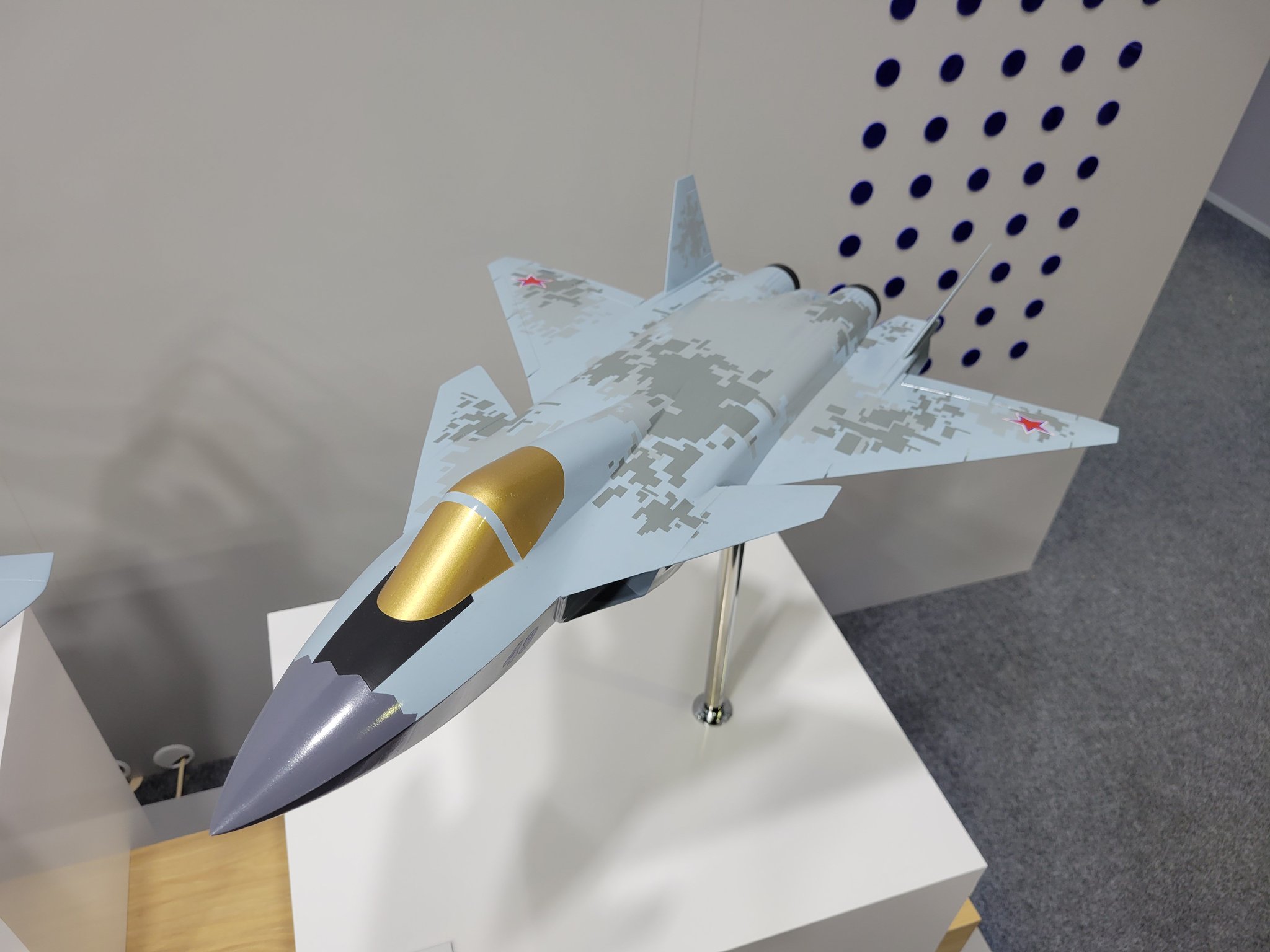
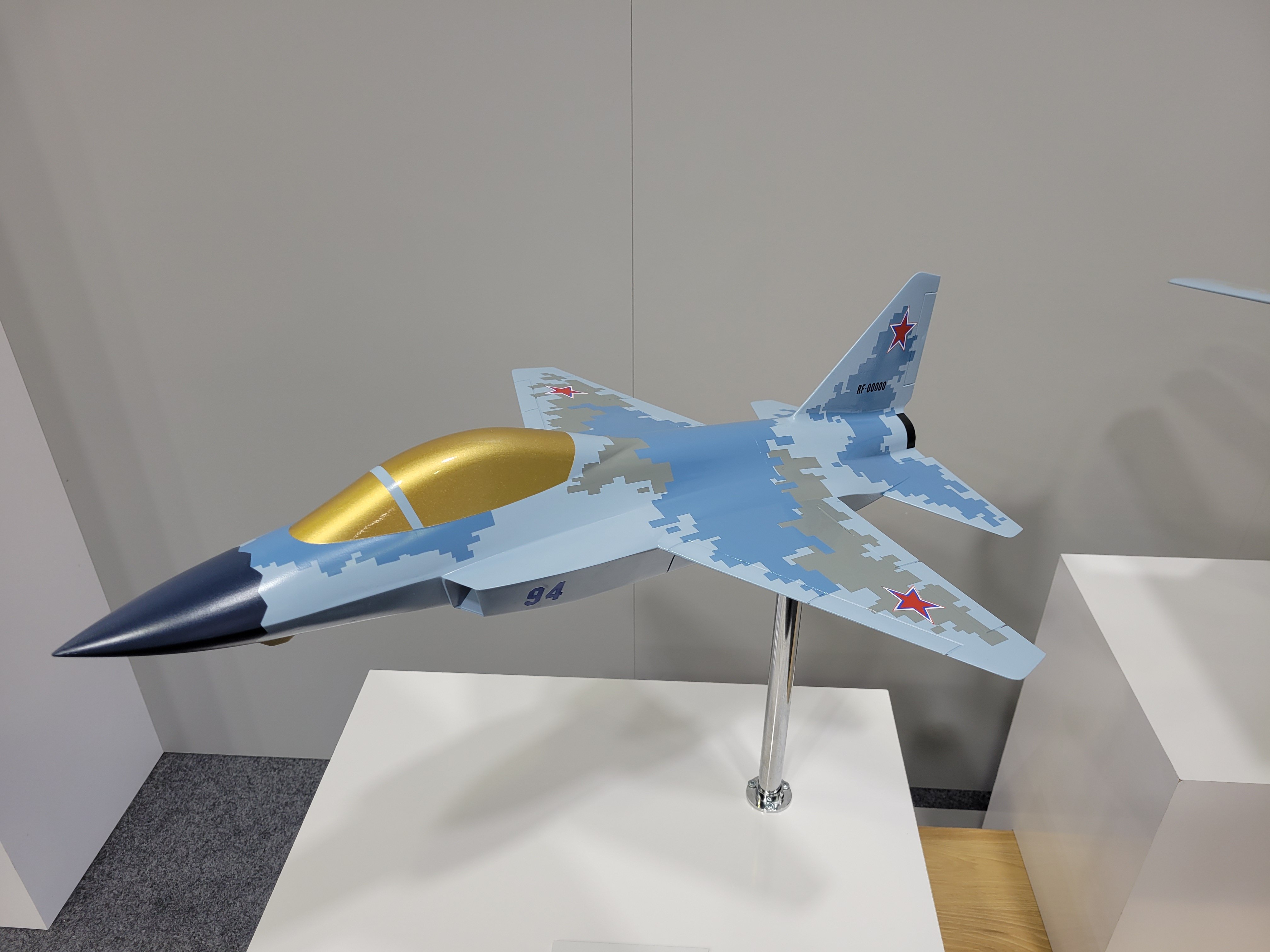
Will it happen?
If I had to bet? No.
KEEP THIS SITE GOING BY SUPPORTING US ON PATREON The Hush-Kit Book of Warplanes will feature the finest cuts from this site along with exclusive new articles, explosive photography and gorgeous bespoke illustrations. Pre-order The Hush-Kit Book of Warplanes here. Thank you. Our controversial merchandise shop is here and our Twitter account here @Hush_Kit. Sign up for our newsletter here. The Hush-Kit Book of Warplanes will feature the finest cuts from this site along with exclusive new articles, explosive photography and gorgeous bespoke illustrations. Pre-order The Hush-Kit Book of Warplanes here.

Jim Smith update
An image of the Checkmate aircraft (or possibly mock-up) has now appeared, and the analysis below has been updated to reflect this.
The aircraft has been reported to be Russia’s first single-engine supersonic low observable tactical fighter, and has been developed by Sukhoi, and is being presented at the MAKS show by Rostec. The stated intent is to ‘rival the US fifth-generation F-35 aircraft’. The aircraft is also described as a domestic light fighter, which will compete with the F-35 in export markets. This latter comment is backed up by a video on the Rostec website which identifies a number of countries by name including India, Argentina, and Vietnam, as well as some elements suggestive of Middle Eastern states.
The new photographs show an aircraft that loosely resemble the earlier ‘teaser’ imagery, but with significant differences in the intakes, fuselage and wing planform.
The ‘Checkmate’ aircraft (Hush Kit reporting name ‘Fleabag’) has a novel diverterless intake under the nose, with a unique V-shaped appearance following the shape of the underside of the forward fuselage. The position of the intake is not dissimilar to the teaser image, but the aperture has a higher aspect ratio V-shaped slot appearance. It’s appearance is definitely a ‘smiley’ intake, and I feel sure this echoes Rostec’s feelings about their very successful publicity campaign leading up to the Checkmate launch.
Looking at the intake, one wonders whether a vari-cowl will be fitted, similar to that on the Su-57 and Eurofighter Typhoon, to allow greater mass flow through the engine in high thrust and low airspeed conditions.

The wing appears to differ from the teaser image. While retaining a highly-tapered, thin, low-aspect-ratio planform, the trailing edge has relatively little forward sweep, resulting in a relatively conventional cropped-delta planform, rather than a near-diamond planform. The planform is similar to the Tejas, the Mirage 2000 and Eurofighter Typhoon, to cite three examples from different sources.
The forward fuselage of the Checkmate aircraft features a strong chine in the plane of the wing, which grows into a highly-swept leading edge root extension, or strake. The intake is located at the start of this strake, and a large door is located in the underside of the strake. While this might be a forward weapons bay, it could also provide access to aircraft systems and equipment.
The main undercarriage legs are widely spaced, and retract forward. As a result, there is significant space under the centre fuselage, which could provide significant volume for a weapons bay, at a location which would be closer to the aircraft centre of gravity.
The rear view of the Checkmate/Fleabag aircraft appears to show a single afterburning nozzle, located between twin butterfly tails. Given Sukhoi experience in the application of thrust vectoring to its heavy fighter designs, it would be surprising if this were not also fitted to the new aircraft.
The teaser image features an Infra-red Seeker Tracker, located ahead of the cockpit, and a radar in the aircraft nose. This is a typical arrangement for a Russian fighter, and is replicated on Checkmate, although separate Rostec imagery has suggested the use of a multi-purpose targeting sensor, like the EOTS system fitted to the F-35. This system is not visible in the new image of Checkmate, but could simply be out if sight on the port side of the aircraft.

The fuselage and tail design of Checkmate are somewhat reminiscent of the McDonnell MFVT (Mixed Flow Vectored Thrust) ASTOVL concept, and although that single-engine aircraft featured twin side-intakes, there is still a resemblance between it and Checkmate/Fleabag. The image shows a model held by the Newark Air Museum, who kindly provided this picture.
The MFVT design was one of the propulsion alternatives examined in early UK-US joint technology studies looking at possible ASTOVL concepts in advance of the JSF program. I am not suggesting that Fleabag is a STOVL aircraft, but rather noting that the fuselage volume taken up in the MFVT for its STOVL system results in a fuselage shape compatible with the internal weapons bays which are a feature of Checkmate/Fleabag.
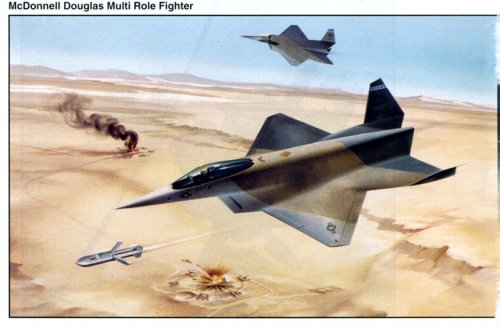
What can we infer about the aircraft? To me, the highly-tapered, low aspect ratio wing suggests that the design is intended to be used for BVR combat. The wing area and aspect ratio suggest that supersonic acceleration, and, with high thrust-to-weight ratio, a vectoring nozzle, and a strake ahead of the wing, instantaneous turn rate, will be strong features of the aircraft. On the other hand, sustained turn rate, required for WVR engagements, will be weaker. The configuration should result in the instantaneous turn rate being structurally, rather than aerodynamically, limited for substantial parts of the manoeuvring air combat envelope.
Whether a low signature is achieved by Checkmate will depend on a number of aspects – not just the shape, but also the materials, the manufacturing standards, and the electromagnetic properties of the surfaces and structure. The novel intake uses shaping of the lower fuselage to provide a diverterless intake, and the relatively high position of the engine will allow a sinuous intake duct to screen the front face of the engine.
There has been much uninformed commentary, suggesting that Checkmate is a copy of the American X-32 or F-35. In my view, there are sufficient original features in the design of the intake, the fuselage, the cockpit, the wing and the empennage, to indicate that is not the case. The similarities are really limited to being a design solution to what may have been similar objectives to those of the JSF program, but without the requirements for STOVL or deck landing.
What, then, is the intended objective, or role, of Checkmate? Limited, and possibly unreliable hints about its performance suggest a maximum speed in the region of Mach 2.0, and a maximum take-off weight of 18 tonnes. This suggests an aircraft in the general class of a MiG 29 replacement. However, the space available for internal stores, and the attention paid to reducing signatures, indicates that tactical strike is also an important role, suggesting that Checkmate may indeed be a Russian Strike Fighter.
From the wording used in the press release – descriptors like ‘domestic light fighter’ and ‘tactical fighter’, and the reference to exporting the aircraft, it could be that the new Sukhoi is intended to be a cheap alternative to the F-35, indicating, perhaps, that some compromises in the signature area might have been made in the interests of containing acquisition, operating and maintenance costs.
With the marketing emphasis on the export market, perhaps the main objective is to provide an exportable multi-role combat aircraft, while retaining the option of a non-exportable version for local air defence and tactical strike. Such an aircraft would complement the Su 57, delivering air superiority, and a future MiG-31-replacement, which would provide strategic air defence.
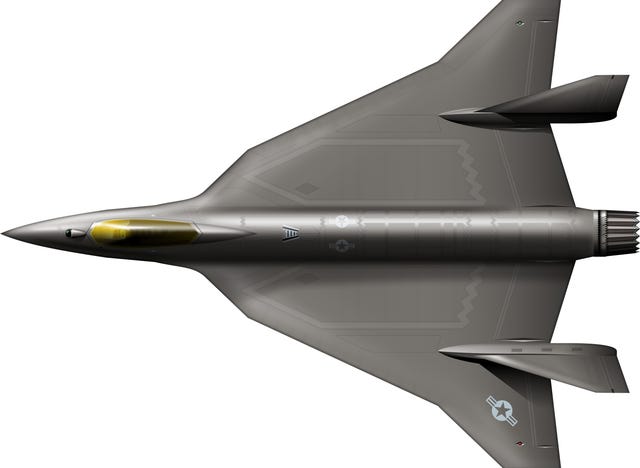
Could the aircraft be a Russian equivalent to the @Hush_Kit F-36 Kingsnake concept, aiming to regain the position once achieved with the widespread use of the MiG-21, by undercutting the cost of the F-35?


Lets call him “Fisher” – it perfectly matches “Checkmate” theme and Bobby deserves it.
Similarity to pelican is another justification.